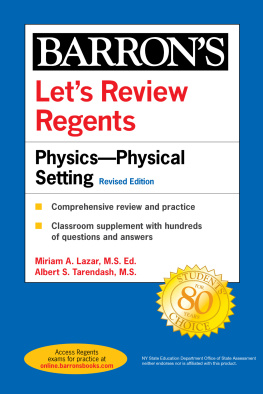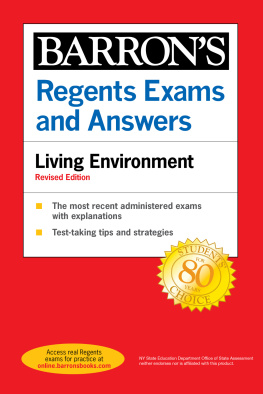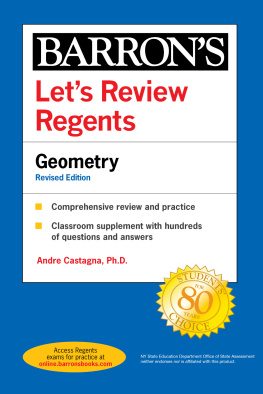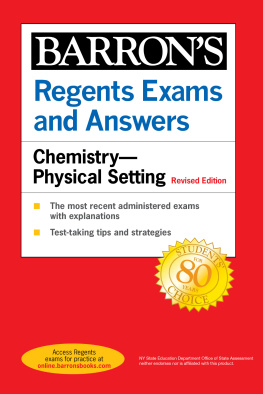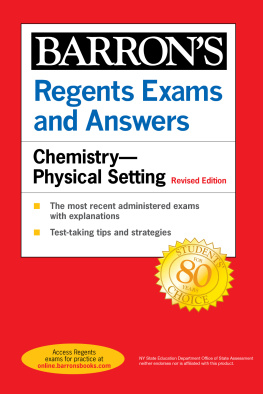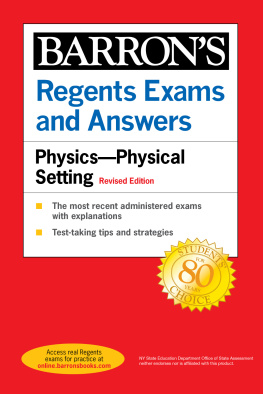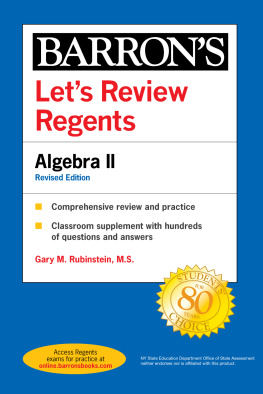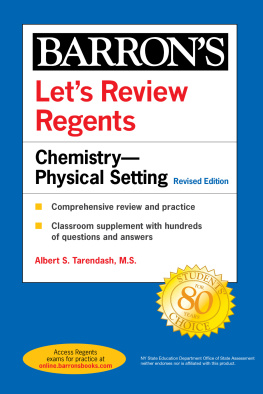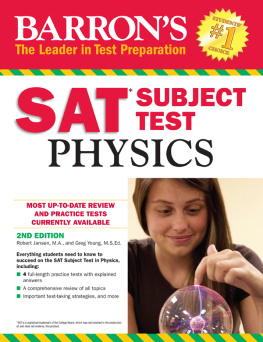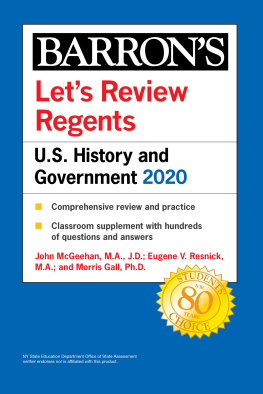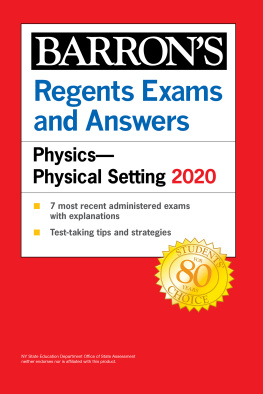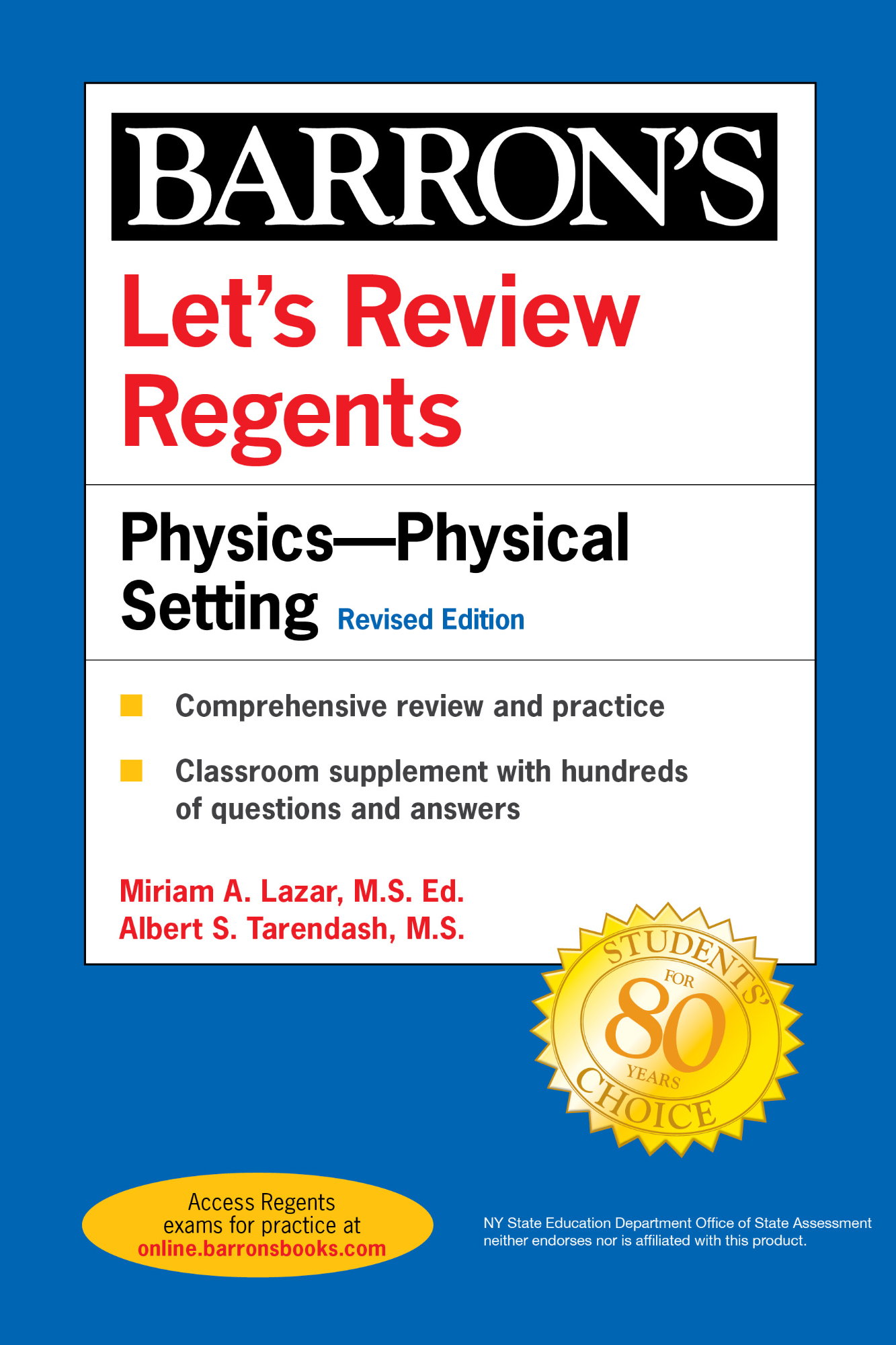Lets Review:
PhysicsPhysical Setting
Revised Edition
Miriam A. Lazar
Principal
Archimedes Academy
for
Math, Science & Technology Applications
Bronx, New York
formerly
Chemistry/Physics Teacher
Stuyvesant High School
New York, New York
Illustration Acknowledgment
From Physics, by Halliday and Resnick. Copyright 1962 by John Wiley & Sons, Inc. Reprinted by permission of John Wiley & Sons, Inc.
Copyright 2021, 2020, 2018, 2017, 2016, 2015, 2014, 2013, 2012, 2011, 2010, 2009, 2007, 2006, 2005, 2004, 2002, 1996 by Kaplan, Inc., d/b/a Barrons Educational Series
All rights reserved.
No part of this book may be reproduced or distributed in any form
or by any means without the written permission of the copyright owner.
Published by Kaplan, Inc., d/b/a Barrons Educational Series
750 Third Avenue
New York, NY 10017
www.barronseduc.com
ISBN: 978-1-5062-7214-6
10 9 8 7 6 5 4 3 2 1
Preface
To the Student
This book has been written to help you understand and review high school physics. Physics is not a particularly easy subject, and no bookno matter how well writtencan give you instant insight into the subject. Nevertheless, if you read this book carefully and do all of the problems and review questions, you will have a pretty good understanding of what physics is all about.
I have designed this book to be your physics companion. It is somewhat more detailed than some review books but is probably much less detailed than your hardcover text. This book is divided into 14 chapters. Each chapter begins with Key Ideas and ends with multiple-choice questions (part A and B-1 Regents style questions) and some (where available) short-constructed response and free-response questions (part B-2 and C Regents style questions) drawn from past NYS Regents Physics examinations. The answers to these questions appear after the glossary. The appendices contain various items of information that are useful in the study of physics and in answering short-constructed response and free-response questions.
This book covers all of the concepts and skills listed in the NYS Physical Setting: Physics core curriculum. In this edition, a significant amount of material that I had included in previous editions as review for a general physics course that went beyond the core (the core being only the minimum to be taught and what is testable by NYS) has at the request of reviewers and my publisher been deleted from this edition. There is only a small amount of material included that is not part of the core, but which I felt helped to clarify concepts that were a part of the core and so remain. A star icon () appears next to chapter subheadings that are not part of the core curriculum. For those students taking the NYS Physical Setting: Physics Regents Examination at the end of your course, I have included general information about this examination and a summary of concepts to be mastered and skills to be demonstrated. These items can be found in Appendix 4. The correlation of chapter material with the NYS Physical Setting: Physics core curriculum Regents is clearly indicated in the Appendix.
If you have any comments about this book, I would appreciate hearing from you. Please write to me in care of the publisher, whose name and address are given on the copyright page.
To the Teacher
Another review book in Physics? Every author feels that he or she has a unique contribution to make, and Im certainly no exception to this rule. It is my belief that a physics review book should be more than an embellished outline of a particular syllabus with questions and problems added. Introductory physics is a difficult subject that requires diligent effort on the part of the student, and any book worth its salt must provide careful and detailed explanations of the material. I wrote the book with these thoughts in mind and I hope that it will be successful for both you and your students.
This book covers all of the concepts and skills listed in the NYS Physical Setting: Physics core curriculum. I have divided the book into 14 chapters because I believe that the material is best presented in this fashion. In this edition, a significant amount of material, that I had included in previous editions as review for a general physics course that went beyond the core (the core being only the minimum to be taught and what is testable by NYS) has at the request of reviewers and my publisher been deleted from this edition. There is only a small amount of material included which is not part of the core but which I felt helped to clarify concepts that were a part of the core and so remain. A star icon () appears next to chapter subheadings that are not part of the core curriculum. You may not feel that my division of the material is appropriate for your teaching style or course, but there is no one correct way to order the material in a physics text. If you are more comfortable with another approach, then use it by all means.
I spent considerable time in working out short-constructed response and free-response problems throughout the text because I believe that is the area where students experience their greatest difficulties with physics. I chose not to pad each section with multiple-choice questions but reserved them for the end of each chapter. In this edition I have included a section of short-constructed response and free-response questions at the end of each chapter. These questions were drawn from past NYS Regents examinations spanning more than 30 years.
I hope that this book will give you some new insights and enable you to plan and execute your physics lessons with a spirit of inquiry. If you have any comments or corrections, please write to me in care of the publisher, whose name and address are given on the copyright page or you can e-mail me at .
I wish to thank my editors at Barrons for their patience and understanding, Mr. Joseph Lazar (my father) for his excellent art work and all my former students at Stuyvesant, who contributed much to the first edition that continues to be included in this edition. I wish to thank Albert S. Tarendash, my teacher, my mentor, and my friend, for his invaluable hard work and effort that went into the creation of the first edition that lives on in this edition.
I continue to dedicate this book to the memories of Dr. Murray Kahn and Dr. Matthew Litwin. Both men were friends and colleagues and outstanding chemistry teachers whose first and last thoughts were always of their students.
Miriam Lazar
Chapter
one
Introduction to Physics
Key Ideas
Science depends on our ability to measure quantities. The SI metric system is used internationally as the standard for scientific measurement. It consists of seven basic quantities (e.g., length and time) and many derived quantities (e.g., speed and density).
Every measurement has a degree of uncertainty that is related to the limits of the measuring instrument. The concept of significant digits helps us to evaluate the degree of uncertainty in a particular measurement.
A graph of data points can indicate whether there is regularity within a set of data and can be used to predict how variables will behave under given conditions.

